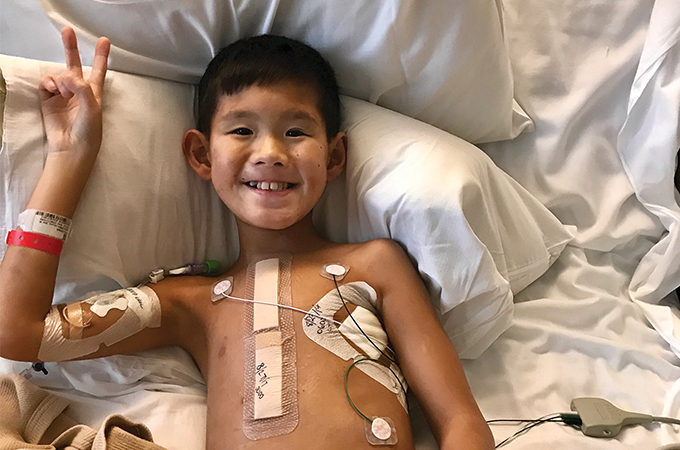Before he came to SSM Health Cardinal Glennon Children’s Hospital, 10-year-old Andrew Neal didn’t know what it was like to feel healthy. He was born with complex heart defects that compromised his circulation and starved his body of oxygen, causing him to feel tired and turning his toes and fingers blue.
Andrew was adopted from China this spring by Allen and Mary Neal of Nixa, Missouri, and was welcomed into a large family of five brothers and three sisters. “We knew he had heart issues when we adopted him, but we didn’t know their extent,” Allen Neal explains. The fourthgrader had seen a doctor in nearby Springfield, but was referred to Cardinal Glennon for surgery that was the only solution to his complicated problem.
Andrew was born with tetralogy of Fallot, a congenital condition that typically causes a hole between the ventricles (bottom chambers of the heart), thickening of the right ventricle, narrowing in the area of the pulmonary valve and problems with the aorta (main artery).
“In Andrew’s case, a heart valve actually was missing and had to be created using an implant,” Neal says. “He had undergone surgery in China, but Glennon doctors said they needed to modify that prior procedure as well.” Andrew saw cardiologist Dr. Wilson King and surgeon Dr. Andrew Fiore, and they helped him and his parents understand the operation he needed from start to finish, Neal says. Since he’d had surgery once before, Andrew had some idea of what to expect, but Glennon doctors and nurses went the extra mile to put him at ease.
“They made a 3-D model of his heart and used it to explain what they planned to do,” Neal says. “It was a perfect scale model that you could open and look inside. We had seen drawings of what the heart would look like, but the model helped us understand exactly how doctors would fix his artery and valve.” It was especially useful as a visual tool because Andrew was still learning English, and that extra level of understanding helped reduce the family’s stress, Neal says. The hospital’s 3-D modeling technology is supported by this year’s Glennon Card fundraising campaign, so other patients and families can have the same peace of mind.
Neal says it took about eight hours for doctors to revise Andrew’s earlier procedure, repair the hole between the ventricles and place the new valve. Andrew stayed in the hospital for roughly four weeks, but he was able to return to school just a few days after going home. “His blood oxygen levels went up right after the surgery, and his color returned to normal,” his father says. “He’s been swimming and playing soccer with his siblings and is ready for more sports! He doesn’t get tired like he used to and feels much better.” Andrew’s doctors don’t think he will need future surgeries, but he still receives regular monitoring.
His parents were understandably worried before the complicated operation, but Neal says their fears were calmed by the compassion and expertise of the hospital’s doctors and nurses. “It’s always difficult to prepare your child for major surgery like this,” he says. “But it was great having medical staff who were so confident and caring.” During Andrew’s recovery, he enjoyed activities like visits from clowns and baseball players, and games with hospital volunteers. “There were all kinds of special events to lift the kids’ spirits,” Neal says. “I’ve never seen a hospital that treats its patients so well.”
He adds, “The best part is, Andrew has been able to go on with life as a normal, healthy child. He has a lot more energy and a positive outlook. We are all pretty excited about that.”








